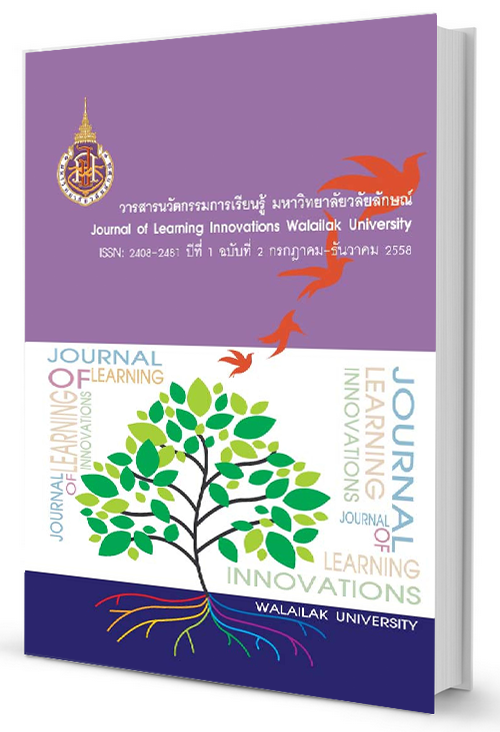Using Grounded Theory to Gain an Insight into How Thai Students Learn English
Abstract
บทความนี้นำเสนอมุมมองต่อโลกที่นำมาใช้ในการเลือกทำงานวิจัยสองแบบคือ การวิจัยเชิงปริมาณ และการวิจัยเชิงคุณภาพ ในบทความนี้ผู้เขียนนำเสนอทฤษฎี ที่ใช้ในการวิเคราะห์ข้อมูลเชิงคุณภาพที่ชื่อว่า Grounded Theory โดยเน้นให้เห็น ลักษณะเด่นของวิธีการ หลักการ และเหตุผลว่าทำไมจึงเลือกใช้วิธีการนี้ร่วมกับ Constant Comparative Method ในงานที่ชื่อว่า “ประสบการณ์การเรียนภาษาอังกฤษ ของนักศึกษาในมหาวิทยาลัยไทย: กรณีศึกษา” ในตอนที่สอง ผู้เขียนบรรยายรายละเอียดว่า วิธีนี้ช่วยให้ได้ข้อมูลเชิงลึกซึ่ง อยู่ในรูปประสบการณ์การเรียนภาษาอังกฤษของนักศึกษา ได้อย่างไร และอธิบายเทคนิคในการเก็บรวบรวมข้อมูลและการวิเคราะห์ข้อมูล อย่างละเอียด ในตอนท้ายของบทความ ผู้เขียนกล่าวถึงวิธีการแก้ปัญหาเรื่อง ความน่าเชื่อถือและความตรงของงานนี้ รวมทั้งสรุปให้เห็นว่างานที่ยากที่สุดใน กระบวนการวิจัยแบบนี้คือการที่ต้องใช้เวลามากในการวิเคราะห์ย้อนไปย้อนมา เพื่อให้มั่นใจในประเด็นที่สรุปได้จากข้อมูล และสิ่งที่ทำให้เกิด ความพัง พอใจในการทำวิจัย คือเป็นกระบวนการเรียนรู้ของนักวิจัยเองอย่างแท้จริง
This paper first introduces two major research orientations: quantitative and qualitative, based on two different world views. Then, Grounded Theory as a format of qualitative research is described with its highlighted features together with the presenter’s rationale why Grounded Theory with the Constant Comparative Method was chosen as the main analytical tool for the study entitled “English Learning Experiences of Students Enrolled at a Thai University: a Case Study”. The second part of the paper deals with how Grounded Theory is used in the study to gain an insight into the experiences of Thai students in learning English. Data collection and data analysis techniques are revealed to support how this insight is derived with the application of Grounded Theory. The problems of reliability and validity and how they were addressed in the study by the researcher are discussed. At the end of the paper, the hardest job in the research process is found to be the amount of time spent until data saturation on such a study and the elements of satisfaction include a deep learning process for the researcher herself.
References
Brown, H. D. (1994). Teaching by principles. Englewood Cliffs, New Jersey: Prentice Hall.
Creswell, J. W. (2009). Research design: qualitative, quantitative and mixed methods approaches. , Newbury Park, CA.: Sage Publications.
Glaser, B. G. & Strauss, A. L. (1967). The discovery of grounded theory and strategies for qualitative research. New York: Aldine Publishing Company.
Guba, E. G. (1990). The Paradigm Dialog. Newbury Park, CA.: Sage Publications.
Hamilton, R. & Ghatala, E. (1994). Learning and instruction. New York: McGraw-Hill.
Nunan, D. (1992). Research methods in language teaching. Cambridge: Cambridge University Press.
Richards, K. (2003). Qualitative inquiry in TESOL. New York: Palgrave MacMillan.
Seliger, H. W., & Shohamy, E. (1989). Second language research methods.Hong Kong, China: Oxford University Press.
Senior, R. (2006). Qualitative research in language teaching. Oxford, Great Britain: Oxford University Press.
Stake, R. E. (1995). The art of case study research. Thousand Oaks California: Sage Publications.
Strauss, A. & Corbin, J. (1990). Basics of qualitative research—grounded theory—procedures of developing grounded theory. Newbury Park, CA.: Sage Publications.
Strauss, A. & Corbin, J. (1998). Basics of qualitative research—techniques and procedures of developing grounded theory. Newbury Park, CA.: Sage Publications.
Wiersma, W. (1995). Research methods in education: an introduction.Boston: Allyn and Bacon.
Downloads
How to Cite
Issue
Section
License
เนื้อหาและข้อมูลในบทความที่ลงตีพิมพ์ในวารสารนวัตกรรมการเรียนรู้ มหาวิทยาลัยวลัยลักษณ์ ถือเป็นข้อคิดเห็นและความรับผิดชอบของผู้เขียนบทความโดยตรง ซึ่งกองบรรณาธิการวารสาร ไม่จำเป็นต้องเห็นด้วย หรือร่วมรับผิดชอบใดๆ
บทความ ข้อมูล เนื้อหา รูปภาพ ฯลฯ ที่ได้รับการตีพิมพ์ในวารสารนวัตกรรมการเรียนรู้ มหาวิทยาลัยวลัยลักษณ์ ถือเป็นลิขสิทธิ์ของวารสารนวัตกรรมการเรียนรุ้ มหาวิทยาลัยวลัยลักษณ์ หากบุคคลหรือหน่วยงานใดต้องการนำทั้งหมดหรือส่วนหนึ่งส่วนใดไปเผยแพร่ต่อเพื่อกระทำการใดๆ จ้อต้องได้รับอนุญาตเป็นลายลักษณ์อักษรจากวารสารนวัตกรรมการเรียนรู้ มหาวิทยาลัยวลัยลักษณ์ก่อนเท่านั้น


